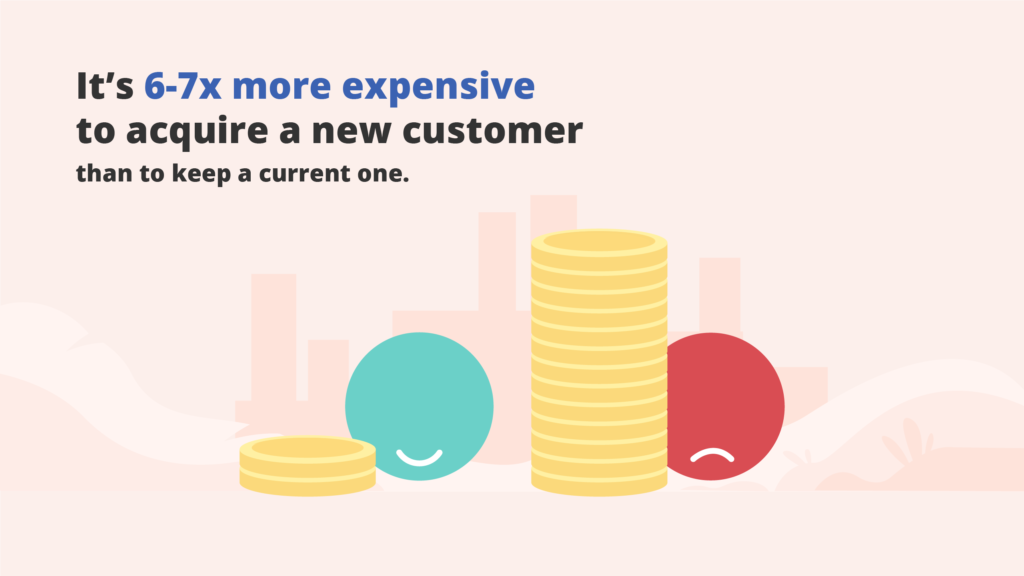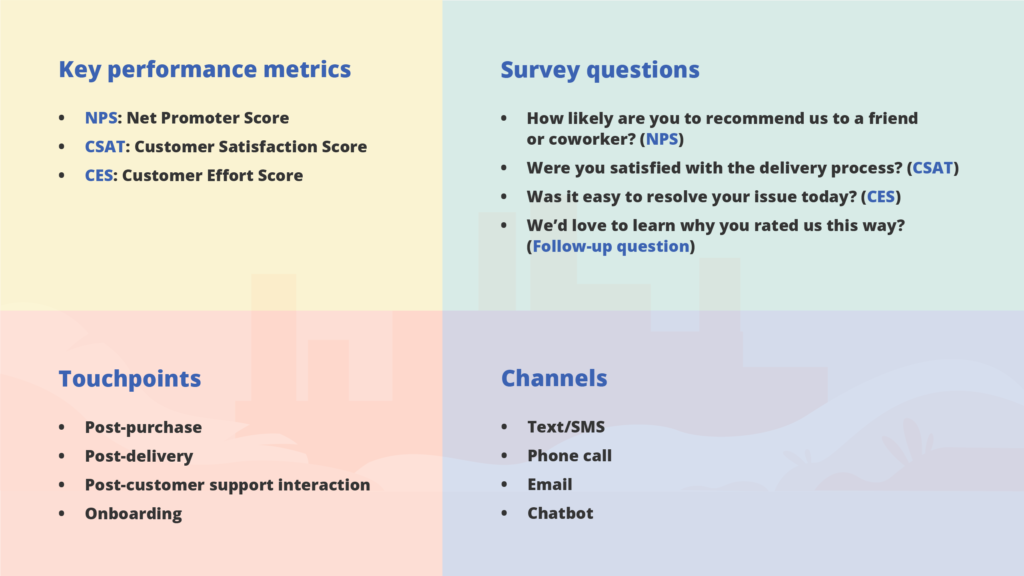Ground your eCommerce strategy in customer satisfaction. Studies found that 96% of dissatisfied customers don’t complain, and 91% of these will simply leave and not return (1). That’s why it’s essential to take action and ask each eCommerce customer how to improve customer satisfaction at your shop. Let’s talk about how to make customers happy, keep them, and grow your bottom line by measuring customer satisfaction and utilising an eCommerce questionnaire.
Why focus on customer satisfaction?
Customer satisfaction in eCommerce is the way to differentiate your shop from your competitors. Particularly as the two basic shopping goals of consumers are customer satisfaction and customer service. Therefore, it’s essential your eCommerce user journey is consumer-centric.
Consider these 3 statistics:
- 72% of customers will tell 6+ people about their good experience (2).
- It’s 6-7x more expensive to acquire a new customer than to keep a current one (3).
- On average, loyal customers are worth up to 10x their first purchase (3).
Happy customers often provide free advertising as they’ll tell others if they like your company. And not only are satisfied customers cheaper to retain than getting new ones, they’re more likely to buy from you than new customers. (And more likely to buy much, much more.)Consider these 3 statistics:

In short, investing in an eCommerce strategy that ensures customer satisfaction will secure your shop’s success. Download our guide for more info: Why customer satisfaction is important: A guide for businesses.
How to improve customer satisfaction
Listen, track and act on consumer feedback. We promise you, you can’t go wrong. Go from asking internally, “How does eCommerce benefit consumers?” to “How do my eCommerce customers think they could benefit from eCommerce?”
Let them tell you what is consumer satisfaction for your shop.
Listen to the Voice of the Customer
An essential part of knowing how to please your customers is seemingly obvious—ask them. 77% of customers say they favor brands that ask for and accept customer feedback (4).
Asking customers their opinions will not only provide you with valuable Voice of the Customer data, it will also show them that you care about them and their experiences.
No really, ask them for feedback
[ca-form id=”44600″ align=”right”]
Collect consumer feedback with a survey. First, determine your goals for the survey before writing it.
Set up your eCommerce questionnaire
- Decide what you want to measure. Which customer satisfaction KPI?
- Decide what to ask them. Which questions?
- Decide when to ask them. Which touchpoint(s)?
- Determine how to ask them. Which channel(s)?
Consider which touchpoints are right for snagging feedback along your ecommerce user journey. Is it a post-purchase or post-delivery survey, a milestone survey, after closing a chat or support ticket survey?
Then, consider your customers. How do they expect to interact with your brand—over text, chat, email or phone? And, how will you position your messaging related to your tone of voice? Will they find the messaging playful, expert, informative, or authentic? Make sure your survey’s wording reflects your company’s personality.
For further tips on customer satisfaction survey tools, check out How to measure customer satisfaction: Methods and tips.
Track your eCommerce KPIs
How to measure customer satisfaction during the eCommerce user journey? Select and monitor one of these eCommerce KPIs (Key Performance Indicators) for measuring customer satisfaction in your shop.
- Net Promoter Score (NPS) measures customers’ long-term loyalty.
- Customer Satisfaction Score (CSAT) measures satisfaction at particular moments in the customer journey.
- Customer Effort Score (CES) measures customer satisfaction based on ease to complete a specific task.
We dive into these individual website customer satisfaction survey questions in this article: How to measure customer satisfaction KPI: NPS, CSAT, and CES.
Note that having at least one of these eCommerce KPIs is an important part of any eCommerce strategy. These metrics can let you know who is loyal and/or a possible brand promoter (NPS) as well as which of your touchpoints could use some improvement (CSAT and CES).

There are several customer satisfaction platforms that provide advanced customer satisfaction measurement tools for measuring customer satisfaction. We recommend getting one that offers your shop customer insights on customer sentiment, customer segmentation, consumer analysis with eCommerce consumer behaviour, and allows you to track and monitor consumer trends.
Act based on feedback
Perform a customer journey analysis with the VoC data and eCommerce KPIs you’ve collected. Use your customer satisfaction measurement tools to gain insights on how to improve unique touchpoints with customer journey mapping.
Then, identify gaps between what your company thinks you’re providing and what customers actually experience. That’s true customer experience management.
As you let your customers tell you themselves how to improve customer satisfaction, you have the knowledge on make them happier! Improve consumer satisfaction and loyalty to ultimately cut costs.
Sources:
- Beal, Andy. Repped: 30 Days to a Better Online Reputation
- Kolsky, Esteban. Presentation at Callidus Customer Conference
- On average, loyal customers are worth up to 10x their first purchase. White House Office of Consumer Affairs
- The Microsoft 2017 State of Global Customer Service Report
